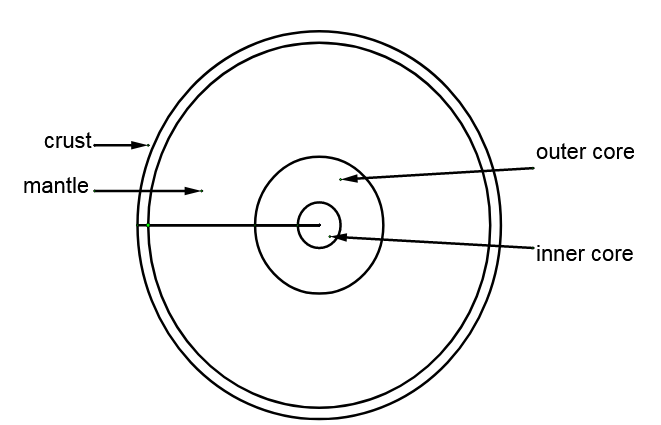
The outermost layer of the earth is called
A.) Crust
B.) Mantle
C.) Core
D.) None of these
Answer
591k+ views
Hint: The earth is divided into four layers which are crust, mantle, outer core and inner core. The innermost layer is the inner core and the outermost layer is crust.
Complete Step By Step Solution:
The earth has been divided on different basis for varied purposes. On the basis of its chemical composition earth is divided into four layers namely inner core, outer core, mantle and crust. This division is from deepest to shallowest. So curst is the outermost layer of earth. A- is the correct option.
Crust is mostly made up of different types of rocks. Crust takes up only 1% of total earth’s volume. The depth of crust varies greatly under ocean and continent. The ocean ranges from 5 km to 10 km, while under the continent it can be up to 50 km deep. Around 47% of the total earth crust is made up of oxygen.

Additional Information:
The thickness of the outer core of earth is about 220 km. The outer core is very hot and has a temperature range of about 4773 K to 5773 K. The inner core of earth has a radius of 1,220 km. It is also extremely hot with a temperature around 5473 K. The mantle of earth has a thickness of 2900 km, more than any other layer. It consists of about 80% of the total volume of earth.
Note: These are not the only bifurcation of the earth's layer. Earth has been bifurcated differently as per purposes of bifurcation. However this is the most common and basic bifurcation used for study earth.
Complete Step By Step Solution:
The earth has been divided on different basis for varied purposes. On the basis of its chemical composition earth is divided into four layers namely inner core, outer core, mantle and crust. This division is from deepest to shallowest. So curst is the outermost layer of earth. A- is the correct option.
Crust is mostly made up of different types of rocks. Crust takes up only 1% of total earth’s volume. The depth of crust varies greatly under ocean and continent. The ocean ranges from 5 km to 10 km, while under the continent it can be up to 50 km deep. Around 47% of the total earth crust is made up of oxygen.

Additional Information:
The thickness of the outer core of earth is about 220 km. The outer core is very hot and has a temperature range of about 4773 K to 5773 K. The inner core of earth has a radius of 1,220 km. It is also extremely hot with a temperature around 5473 K. The mantle of earth has a thickness of 2900 km, more than any other layer. It consists of about 80% of the total volume of earth.
Note: These are not the only bifurcation of the earth's layer. Earth has been bifurcated differently as per purposes of bifurcation. However this is the most common and basic bifurcation used for study earth.
Recently Updated Pages
Master Class 12 Business Studies: Engaging Questions & Answers for Success

Master Class 12 Economics: Engaging Questions & Answers for Success

Master Class 12 English: Engaging Questions & Answers for Success

Master Class 12 Maths: Engaging Questions & Answers for Success

Master Class 12 Social Science: Engaging Questions & Answers for Success

Master Class 12 Chemistry: Engaging Questions & Answers for Success

Trending doubts
Which places in India experience sunrise first and class 9 social science CBSE

Fill the blanks with the suitable prepositions 1 The class 9 english CBSE

Write the 6 fundamental rights of India and explain in detail

Difference Between Plant Cell and Animal Cell

What is pollution? How many types of pollution? Define it

What is the full form of pH?




